The Seven Greyhawk Classics of the Ancient World
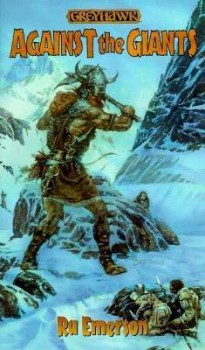 I’ve been pretty hard on Greyhawk novels. They’ve been the butt of more than a few jokes — both mine and others — from those of us who enjoy reviewing and talking about the fantasy genre.
I’ve been pretty hard on Greyhawk novels. They’ve been the butt of more than a few jokes — both mine and others — from those of us who enjoy reviewing and talking about the fantasy genre.
I’m generally pretty forgiving, especially with novels of adventure fantasy. What can I tell you — I’m a fan. But when books can’t be bothered to clamber over the very low bar of my expectations, I’m as capable of a harsh review as anyone.
The novels of Gary Gygax — and in particular his Greyhawk books — routinely limboed under that bar with room to spar, and I’ve said as much in print several times over the years.
Now, I’m second to none in my admiration of Gygax. I consider the man one of the great creative minds of the 20th Century, full stop.
I believe his work with D&D and Advanced D&D — especially the original hardback rules, and the incredibly inventive adventure modules that accompanied them, such as Descent into the Depths of the Earth and The Temple of Elemental Evil — was directly responsible for the mainstream acceptance of fantasy, as manifested in modern role playing obsessions like World of Warcraft and Warhammer.
But his novels? Poo poo.
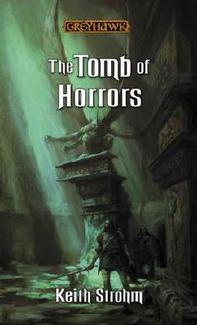 However, Gygax wasn’t the only one to pen Greyhawk novels.
However, Gygax wasn’t the only one to pen Greyhawk novels.
Some of them — especially the so-called Greyhawk Classics published in honor of TSR’s 25th anniversary — are remembed quite fondly.
Written by Paul Kidd, Ru Emerson, Keith Francis Strohm, and Thomas M. Reid, and based on some of TSR’s most famous adventure modules, including Against the Giants, Tomb of Horrors, and Keep on the Borderlands, the seven Greyhawk Classic novels formed a nostalgic return to some of the most fondly-remembered adventure settings in gaming.
They were published in mass market paperback by TSR (later Wizards of the Coast) between July 1999 and February 2002, beginning with Against the Giants and ending with Tomb of Horrors.
Here’s the other thing you need to know about the Greyhawk Classic novels: you can’t have them.
They’re among the most collectible D&D novels ever published, and that’s saying something.
The seven novels in the series are:
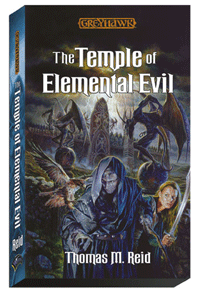
- Against the Giants by Ru Emerson (July 1999)
- White Plume Mountain by Paul Kidd (Oct 1999)
- The Temple of Elemental Evil by Thomas M. Reid (May 2001)
- Descent into the Depths of the Earth by Paul Kidd (June 2000)
- Queen of the Demonweb Pits by Paul Kidd (Oct 2001)
- Keep on the Borderlands by Ru Emerson (Nov 2001)
- The Tomb of Horrors by Keith Francis Strohm (Feb 2002)
The Greyhawk Classics were greeted with considerable fanfare when they were first announced.
It seemed like a natural enough idea — novels set in the very settings so familiar to millions of enthusiastic fantasy readers. Why hadn’t anyone thought of it before?
The first novel in the series, Ru Emerson’s Against the Giants, was based on perhaps the most famous (and fondly remembered) set of RPG modules ever created: Gygax’s three-part adventure series beginning with Steading of the Hill Giant Chief and continuing with Glacial Rift of the Frost Giant Jarl, and Hall of the Fire Giant King.
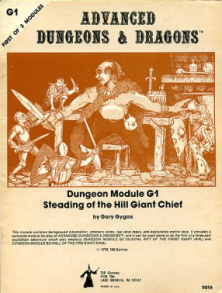 All three modules first appeared in 1978. While they could be enjoyed separately, when played together they formed a gradually accelerating narrative of a sinister force manipulating bands of hostile giants into attacking human settlements.
All three modules first appeared in 1978. While they could be enjoyed separately, when played together they formed a gradually accelerating narrative of a sinister force manipulating bands of hostile giants into attacking human settlements.
The modules had all the elements of great fantasy: terrific villains, larger-than-life characters, mystery, betrayals, and three wonderfully realized and vastly different settings — the wooden fortress of the hill giants, the remote ice rift of the frost giants, and the lethal hall and obsidian caves of the fire giants.
And just who was that sinister force manipulating the giants behind the scenes?
That’s one of the most memorable moments in gaming history: the first appearance of the villainous Drow — the subterranean dark elves who have since become some of the most ubiquitous villains in modern fantasy — in the form of the formidable Eclavdra, high priestess of Lloth and total femme fatale hottie.
In 1999, as part of their 25th Anniversary celebrations, TSR published Ru Emerson’s novel Against the Giants simultaneously with an updated version of Gary Gygax’s original adventure series, also titled Against the Giants.
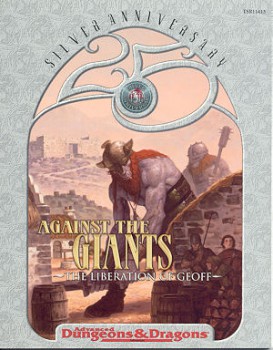 While the re-tooled adventure was well received, the novel was not. Here’s part of what I wrote in my SF Site review in early 2000:
While the re-tooled adventure was well received, the novel was not. Here’s part of what I wrote in my SF Site review in early 2000:
The early sections, in which Vlandar and his companions attempt to raise a band of adventurers for a very dangerous (i.e. nearly suicidal) mission, are probably the best in the book.
The ride’s a little more uneven after that. Emerson, author of The Art of the Sword and The Thief of Hermes, is a gifted and prolific writer, but it’s more obvious than usual that this book was put together on a tight schedule. The biggest errors are all editing mistakes, as when the adventurers discuss the fact that Hill Giants are nocturnal and then forget about it completely, or make plans around a hidden stairway in the giant enclave that they’ve never discovered. Equipment appears suddenly, characters change places… much the same thing that happens during a routine D&D session, I suppose, so it can all be forgiven.
As engaging as the book is on several levels, I was a little disappointed to have one theory quickly confirmed: dungeon crawls, no matter how exciting, make a tough transition to prose. Despite my familiarity with all 3 adventures, I got hopelessly lost once the action moved into the corridors of the Steading. It’s so confusing in fact, and there’s so little effort made to orient the reader during the dizzying flights and melees up and down numerous dark and dangerous corridors, that I can easily believe the book was intended to be published with maps.
Other critics were more blunt. Here’s a snippet from one of the gentler (and more accurate) Amazon reviewers, Steven Sammons:
This book attempted to take three really fine D&D modules and cram them into one small novel. The results are scattered plotlines, undeveloped characters, and frankly unbelieveable resolutions. Emerson did a decent job of uniting the three modules into a plausible storyline, but so much was going on that in truth this needed to be 2 or 3 books, not one. Because she had to fit so much in, the author glossed over character development and ran the group through some tough situations so easily that at times the reader would snort in disbelief. At times the action would stop just long enough to allow the group (and the reader) time to catch their breath and actually interact with one another, then- zoom! Off they go again. By the end of the book they were actually running to get done before they ran out of pages! Kind of ridiculous.
There are many disappointments waiting the D&D purist, as Emerson here commits so many faux paus that either she had never played the game before, or she was playing a different one than I did as a kid… and giants, which were pretty tough adversaries both in the game and in most other literature, fell like nine-pins to almost everyone in the party, even to the main charcter Lhors, who was just a farm kid!
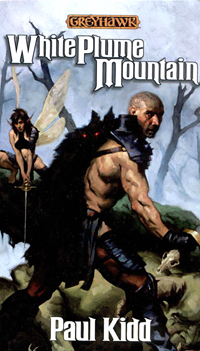 Things began to turn around with the second book, White Plume Mountain, written by Paul Kidd and based on Lawrence Schick’s 1979 adventure.
Things began to turn around with the second book, White Plume Mountain, written by Paul Kidd and based on Lawrence Schick’s 1979 adventure.
Again, taken from a typical Amazon review, this one by Archibald Baal:
Paul Kidd is a comic book writer, and it shows. The author doesn’t spend a lot of time establishing mood, or world-building, or even using depth in his characterization. He concentrates on action and witty banter, like the game the book is drawn from… The characters unashamedly spout anachronisms at every turn — you can almost see the players pausing between handfuls of Cheetos to rattle off a modern idiom or two. The faerie is like something out of a Boris Vallejo ilLUSTration: there’s a point where the word “naked” is used to describe her condition twice in a matter of about five sentences. When she’s not nude, she’s busy trying to assemble an outfit which is as suggestive as is possible for an adolescent male to imagine — which is the whole point of the joke, obviously.
The book adamantly refuses to apologize for its lack of modern fantasy acoutrements such as rich motivations and character complexity… and bludgeons its way through to win your heart regardless. If you seek serious fantasy fare, or mindless Dragonlance drivel, look elsewhere. This book is beer and pretzels-type fare, with all the swashbuckling and lack of seriousness that implies… but unless I miss my mark, Paul Kidd has also embedded the book with some serious commentary on the D&D game itself, and how it has evolved in the years since its infancy.
In fact, unless I’m ascribing more genius to the work than Kidd intended, the book acts as a deconstruction of legacy D&D campaigns and even the modern angst-ridden White Wolf-style gaming heroes… and it works!
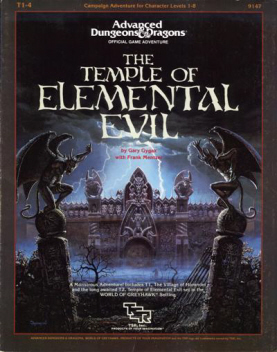 Thomas M. Reid penned the third installment, an adaption of the 1985 mega-adventure The Temple of Elemental Evil written by Gary Gygax and Frank Metzner.
Thomas M. Reid penned the third installment, an adaption of the 1985 mega-adventure The Temple of Elemental Evil written by Gary Gygax and Frank Metzner.
Here’s a typical review, from Dungeons and Digressions:
It was just what I needed – nothing too deep, nothing too complicated, nothing that would give me an even worse headache than what I already had…
As one might expect, D&D rules were apparent throughout. For example, the elven wizard memorizing and preparing his spells at the beginning of the day and the thief-like character stealthily serving as the party’s recon and continually sniffing out traps. And of course familiar spells like Ye Olde Magic Missile.
It’s not Tolkien, but it was fun and got me more into the mood to game.
Ironically, while Gygax’s version is one of the most famous RPG adventures every created, most readers today are familiar primarily with the popular 2003 computer game released by Troika Games and Atari.
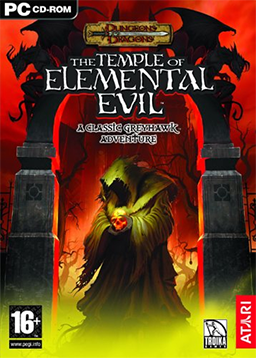 Also based on Gygax’s adventure, the computer game version was highly unusual in that it was a faithful adaption of a pen-and-paper setting. Fortunately The Temple of Elemental Evil was nicely suited for computer gaming, with its compartmentalized levels, rich background, and unusually linear plot.
Also based on Gygax’s adventure, the computer game version was highly unusual in that it was a faithful adaption of a pen-and-paper setting. Fortunately The Temple of Elemental Evil was nicely suited for computer gaming, with its compartmentalized levels, rich background, and unusually linear plot.
Paul Kidd wrote the fourth Greyhawk Classic volume, Descent into the Depths of the Earth, and it appeared in print in June 2000.
A direct sequel to Against the Giants, and featuring the return of the loathsome Drow, the book manages to pull off the neat trick of not bothering to pick up the story of any of the characters from Ru Emerson’s novel, but instead continues the adventures of the ranger Justicar and the faerie Escalla from White Plume Mountain, as they venture deep into the earth and discover a Drow city — and just how deep the roots of the conspiracy first revealed in Steading of the Hill Giant Chief truly are.
Here’s a snippet of a typical Amazon review, this one by from B.Choo:
The sequel to White Plume Mountain feels a bit more rough-edged and awkward in terms of story flow but still retains the fast paced humour and cynical dungeoncrawling mentality that made its predecessor such a delight to read. The characters have been considerably more fleshed out but have lost nothing of their refreshing personalities – even Polk grows on you after a while. What really caught my eye are some of the most innovative ideas for magic-use I’ve seem yet, not to mention some of the most risque imagery and innuendos I’ve seen in an AD&D novel (again probably slipped past the editors). Reading White Plume Mountain beforehand is essential and for those who have actually played the original TSR module, there is an added level of nostalgia (“Geez, why didn’t the party think of doing THAT!?”)
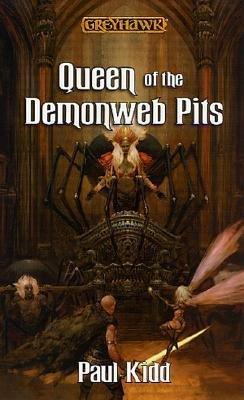 Kidd returned for a third time with Queen of the Demonweb Pits, the culmination of the adventure that began with Against the Giants.
Kidd returned for a third time with Queen of the Demonweb Pits, the culmination of the adventure that began with Against the Giants.
Based on the 1980 adventure written by David Sutherland (with notes and direction by Gary Gygax) which featured the climactic showdown with the demon Queen Lloth, god of the Drow, Kidd’s final book in the series is widely considered the best of the lot, a rousing mix of action and humor.
It averaged 4 stars out of five on Good Reads and 4.5 stars at Amazon, not bad at all for a game tie-in novel.
Here’s a clip from one of Amazon’s better short reviews, this one written by J. Biel:
What works so well in The Queen of the Demonweb Pits is when these characters are grouped together they are a hoot, and the silly banter is first rate. They stumble from one misadventure to another all the while saving the world.
The Justicar, a ruthless ranger with a haunted past (aren’t they all), carries a sentient sword that preaches chivalry. To top it off, he wears an animated, fire breathing, hellhound pelt named — of all things — Cinders that can spell and doesn’t like to get wet… something about smelling like a wet dog.
Comic relief comes in the abbreviated but pert form of Escalla, a Fairy whose self proclamation of having the cutest bottom in all the land and penchant for slinky attire strikes a contradictory visual to her rough and tumble, kleptomaniac actions. I won’t even go into the fact that she keeps several bottles of giantism around for those “special moments” between her and her man.
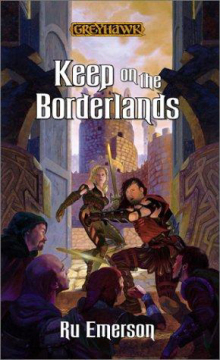 In November 2001 Ru Emerson provided the sixth title in the series with Keep on the Borderlands, based on Gygax’s 1979 adventure of the same name. This was generally considered much more successful than her first effort.
In November 2001 Ru Emerson provided the sixth title in the series with Keep on the Borderlands, based on Gygax’s 1979 adventure of the same name. This was generally considered much more successful than her first effort.
Here’s an excerpt of a review from Books for a Buck:
Swordswoman Eddis has just finished a job as a caravan job and is looking for a little relaxation when a new opportunity opens. Bandits have been raiding the local town, cutting off its trade routes and threatening its destruction. Together with adventurer Jerdren and a group of caravan guards and town armsmen, Eddis sets off on an adventure. What starts out as a simple raid on a bandit camp escalates to a full-scale cave invasion against kobolds, orcs, and the undead.
Author Ru Emerson keeps up a steady flow of adventure and conflict. In keeping with the Greyhawk series, the book frequently feels more like a role-playing game rather than a novel — with our heros entering a possibly infested cave, facing enemy guards, and pocketing some random treasure.
Fans of role-playing games may enjoy this novelization of what feels like a real game. Emerson works hard to add character depth to Eddis, with her semi-adoption of a young child as a major element.
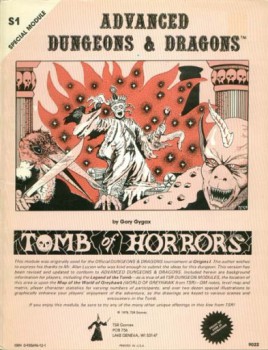 The final volume in the Greyhawk Classics, The Tomb of Horrors by Keith Francis Strohm, appeared in February 2002.
The final volume in the Greyhawk Classics, The Tomb of Horrors by Keith Francis Strohm, appeared in February 2002.
Based on Gary Gygax’s notoriously difficult player-killer The Tomb of Horrors (1978), the module that ended more adventuring careers than any other, Tomb won this nice bit of praise from D&D author Bruce R. Cordell, author of the 1998 mega-adventure Return to the Tomb of Horrors:
There was a double hook with Tomb of Horrors — Keith is a friend, and I wrote a game product related to this title. Truth to tell, I wanted to write this book. So you see, Keith already had a few marks against him before I picked it up. So I read through the first scene. Oh my God, can they publish this stuff? Apparently, they can. The author is a nice guy, but horror sleeps below his placid surface. If you’ve ever wanted to know what it felt like to be crucified, this book is for you. This scene sets the tone for the antagonist, and does so spectacularly well.
Then we meet the protagonist, Kaerion, in the next chapter. A down-on-his-luck swordsman washing away his sorrows in drink? Yes, but it turns out he has a lot to wash away. He was once a paladin, now fallen, whose holy sword continually torments him with the memory of what he once was. No matter how he tries to dispose of the holy blade, it always reappears. This is great stuff.
So, the book begins to shape up. Two groups have designs on the legendary Tomb of Horrors. One group evil, one good. Each has a fair way to go before they reach the doorstep of the ancient tomb. But that’s where the horror truly begins. More importantly for me, it is also where we discover if Kaerion can finally achieve redemption.
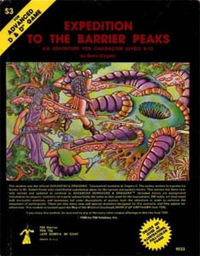 Pay no attention to various references on the Internet to the eighth Greyhawk Classic, Expedition to the Barrier Peaks, by Roland Green (supposedly published in 2000, according to Amazon).
Pay no attention to various references on the Internet to the eighth Greyhawk Classic, Expedition to the Barrier Peaks, by Roland Green (supposedly published in 2000, according to Amazon).
It doesn’t exist. It probably fell victim to scheduling problems and was canceled before publication.
Too bad. Gary Gygax’s 1980 module Expedition to the Barrier Peaks, a strange blend of fantasy of science fiction and fantasy — featuring a bizarre alien craft, packed with alien monsters and weird and potent technology and equipment, which has crashed-landed on a remote mountain top — is a blast to play, and it would have been fun to see an original cast of characters carry off a play on a stage well known to so many readers. At the very least, I would have loved to read the scene where they encounter the mind flayer with the blaster…
While it’s clear the Greyhawk Classics weren’t big sellers for TSR/WotC a decade ago, they have found a better reception in re-runs.
These seven books are in considerable demand on the collector’s market, to varying degrees. If you want to collect them in good condition, you’ll need deep pockets.
While price reports are always tricky (since prices can fluctuate quickly), what follows is a snapshot of the lowest prices currently commanded for new copies on Amazon.com:
| Against the Giants | $57.89 |
| White Plume Mountain | $99.98 |
| The Temple of Elemental Evil | $13.50 |
| Descent into the Depths of the Earth | $50.00 |
| Queen of the Demonweb Pits | $15.99 |
| Keep on the Borderlands | $35.96 |
| The Tomb of Horrors | $27.99 |
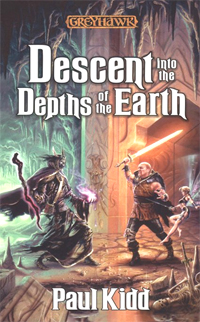 As I was doing research for this article, and I noticed the sky-high prices for many of these books, I went digging for my copies of the Greyhawk Classics and was relieved to note that I enthusiastically collected them all as they came out — with one exception.
As I was doing research for this article, and I noticed the sky-high prices for many of these books, I went digging for my copies of the Greyhawk Classics and was relieved to note that I enthusiastically collected them all as they came out — with one exception.
I didn’t have much interest in White Plume Mountain, apparently… probably because it’s the only module I’ve never played.
Typical of my luck, you’ll note it’s now the most expensive of the lot, by a wide margin. Looks like it may be a while before I can afford to complete my collection.
If, like me, you have many fond memories of Greyhawk, but found the early Greyhawk novels to be underwhelming, I hope you’ll have a look at the Greyhawk Classics.
It was a fun series, and it’s well worth collecting, particularly if you don’t mind buying used copies.
All except for White Plume Mountain. Kindly stay away from that one — at least until I can claim my copy!
I have fond memories of the first Gord book. It was light entertainment and a whirlwind tour of my beloved World of Greyhawk. I did actually read the entire series (and, boy, do I wish I could sub in another set of books for that lost reading time). It got sadly comical at the end, with GG destroying the world he’d lost control of and replacing it with different but very similar one.
I never bothered with the novels you detail above. I’d learned my lesson about fiction based on D&D settings (although not WFRP–I have a Gotrek and Felix omnibus on my to-be-read shelf). If another book is never written, I still won’t get through everything I want to read, so I’m not too worried about missing out, and I’m not nostalgic for the above modules like I am for the wider World of Greyhawk.
Hi Jeff,
Yes, it was DANCE OF DEMONS, one of Gygax’s GORD THE ROGUE novels, that convinced me he had no business being a novelist. I had heard many terrible things about them over the years, but thought I could overlook clunky prose to spend some time in Greyhawk.
I was wrong. I could barely read 20 pages. Perhaps some of the other GORD books are superior, but I can’t imagine making the effort to find out at this point.
To be fair, the books have their fans, and they were clearly written to appeal to 7th-grade boys. They are also extremely valuable collector’s items today. Here are the lowest prices for new copies of four of the GORD novels on Amazon.com:
Saga of Old City (Greyhawk Adventures #1) – $167.74
Night Arrant (Gord the Rogue) – $279.08
Dance of Demons (Gord the Rogue) – $119.33
City of Hawks (Gord the Rogue, Book 3) – $110.46
> I’d learned my lesson about fiction based on D&D settings (although not
> WFRP–I have a Gotrek and Felix omnibus on my to-be-read shelf).
Indeed – Black Library’s WARHAMMER novels, including the Gotrek and Felix books, are some of the best S&S being published today. They deserve more attention.
> I’m not nostalgic for the above modules like I am for the wider World of Greyhawk.
I forgot that there are fans of Greyhawk who appreciated the world for reasons well outside the original D&D adventures. I never used the campaign setting for my own games, but there were thousands who did.
Personally I loved the Paul Kidd books. Never got to read much the Gord books, though I did love an anthology book of Greyhawk stories.
Also like most of the Ravenloft books. Haven’t read all of them, but have most, but I like them good, especially the Strahd/Knight of the Black Rose ones. There was a neat Jekyll/Hyde character one too.
Saga of Old City (Greyhawk Adventures #1) – $167.74
Yes, well, I couldn’t sell my copy for $0.79, and it doesn’t even have any loose pages. (That’s as positive as I can be about it’s physical condition. I bought it used. 🙂
Sea of Death is the Gord book I’ve heard the most positive comments on, but I didn’t care for it. I believe that was the switch from mind-candy length to epic length. The title always throws me too, as it takes place in the Sea of Dust.
I think the Slavers series was the only one of the big series that I went all the way through. After that, our characters were off and running in the world at large, with the occasional module making an appearance, but usually not as something we were expected to “finish.” A lot of politics, a lot of wars, a lot of adventures for one, two, or three characters. (We ran those characters off and on for 10 years real time, 20+ game time.)
We had a different campaign for Temple of Elemental Evil, but I had to bail early on that due to grad school.
Good Article, I really enjoyed those books way back when. In one of the Spectrum art books actually had a picture of the artwork for the Expedition to the Barrier Peaks novel in the unpublished art section.
Hi Jeff!
> Yes, well, I couldn’t sell my copy for $0.79, and it doesn’t even have any loose pages.
I have no idea if anyone is selling copies at Amazon for $167.74 either. 🙂
These prices are a reflection only of what a small number of seller think they may be able to get for a certain book.
Of course, that’s precisely true of virtually ALL rare book prices, so that’s not much of a caveat.
Grimball4,
> one of the Spectrum art books actually had a picture of the artwork for the
> Expedition to the Barrier Peaks novel in the unpublished art section.
Really? I’ll have to dig that up. I’d love to see it. Did it feature a mind flayer??
The cover art to TEMPLE OF ELEMENTAL EVIL is another mystery — my paperback has the cover art above, but the cover art at Amazon (and elsewhere) is very different. Not sure if that means there’s a later printing with a different cover, or WotC changed the art at the last minute and Amazon never caught on.
[…] Despite — or perhaps because of — its killer rep, the module is still highly regarded today, and has been remade and expanded several times, most recently as a 4th Edition hardcover by Ari Marmell and Scott Fitzgerald Gray in July 2010. This isn’t that version. This is a bare-bones conversion of the original adventure for 4th Edition rules, written by Scott Fitzgerald Gray and mailed out to members of the RPGA as part of the DM Rewards program. Instead of the separate art booklet — one of the most famous features of the original release, which allowed players to gawk in wonder at detailed renderings of the horrific things that had just killed them — this edition incorporates most of the original art into the body of the module. The cover is also recycled from the 2002 Greyhawk novel of the same name by Keith Francis Strohm (which we last discussed in “The Seven Greyhawk Classics of the Ancient World,” here). […]
[…] setting written by Paul Kidd (who I assume is the same Paul Kidd who authored the best of the Greyhawk Classic novels, White Plume Mountain, Descent into the Depths of the Earth, and Queen of the Demonweb […]
[…] the first two, then Rose Estes took over authorship on the remaining four. Then there are five Greyhawk Classics, each a stand-alone novelization of a classic Dungeons & Dragons module. We […]
[…] setting written by Paul Kidd (who I assume is the same Paul Kidd who authored the best of the Greyhawk Classic novels, White Plume Mountain, Descent into the Depths of the Earth, and Queen of the Demonweb […]